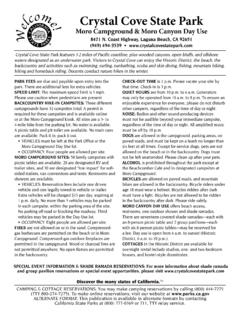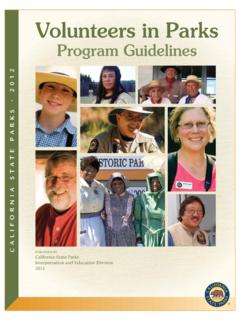Transcription of Mount Our Mission Tamalpais T - CA State Parks
1 MountTamalpaisState park MissionThe Mission of California State Parks is to provide for the health, inspiration and education of the people of California by helping to preserve the State s extraordinary biological diversity, protecting its most valued natural and cultural resources, and creating opportunities for high-quality outdoor Tamalpais State Park801 Panoramic HighwayMill Valley, CA 94941(415) 388-2070 2007 California State Parks (Rev. 2016)California State Parks supports equal access. Prior to arrival, visitors with disabilities who need assistance should contact the park at (415 ) 388 -2070. If you need this publication in an alternate format, contact State Box 942896 Sacramento, CA 94296-0001 For information call: (800) 777-0369 (916) 653-6995, outside the 711, TTY relay panorama from the 2,571-foot peak is breathtaking.
2 On a clear day, view the Farallon Islands out to sea, the Marin County hills, Mount Diablo, San Francisco, and the hills and cities of the bay. North of San Francisco s Golden Gate Bridge, Mount Tamalpais State park rises majestically from the heart of Marin County. Mount Tamalpais captures our attention with its sweeping hillsides cloaked with chaparral-covered ridges, grasslands, and oak woodlands. Deep canyons filled with solemn redwood groves intersect these ridges and slopes to create a diverse environment for a wide array of plant and animal breathtaking panorama from Mount Tamalpais s 2,571-foot peak includes the Farallon Islands 25 miles out to sea, the Marin County hills, San Francisco Bay, the East Bay, and Mount and summer temperatures are warm, with average highs in the 70s and 80s.
3 Fall and winter can be cool, with temperatures in the 50s; fog is HISTORYN ative PeopleThe Coast Miwok lived on or near Mount Tamalpais , staying near water sources throughout present-day Marin County. These Native Californians hunted small animals and deer, collected acorns, and gathered flora, marsh plants, and shellfish. They made baskets and clamshell disk beads, trading them for locally unobtainable resources, such as high-grade obsidian from Lake County tribes. The Coast Miwok had a rich culture and a complex and intricate language. However, their way of life changed soon after the arrival of 1770 two explorers, Captain Pedro Fages and Father Juan Cresp , named the mountain La Sierra de Nuestro Padre de San Francisco.
4 This was later changed to the Miwok word Tamalpais (tam-al-pie-us), which, roughly translated, means bay mountain or coast mountain. Mount Tamalpais Scenic RailwayResidents of San Francisco, whose population exploded after the 1848 gold discovery, used Mount Tamalpais for recreational purposes. Trails were developed, and a wagon road was built to the top of the mountain in Mount Tamalpais Scenic Railway, completed in 1896, carried visitors to the mountaintop and the Summit Tavern, a hotel and restaurant. The slope from Mill Valley to the summit was so steep that the railroad had to negotiate 281 curves, equivalent to 42 complete circles, billing itself as the Crookedest Railroad in the World.
5 In the section known as the Double Bow Knot, the track paralleled itself five times within 200 yards. In 1907 the gravity car was designed to transport visitors from the top of the mountain to the redwood-filled canyon of Muir Woods. Requiring only gravity and a brake, open-air rail cars carried passengers down the mountain to Muir Woods at an exhilarating 12 mph. The railroad and gravity cars allowed sightseers to travel from Mill Valley to the summit, down to the Woods, and back to Mill Scenic Railway s famous gravity cars were popular until the advent of the automobile and the construction of Ridgecrest Boulevard in 1925. A gravity car replica is displayed at the Gravity Car Barn on East EffortsOver the years, millions have flocked to the mountain, affectionately called Mount Tam, to relish the spectacular views and hike its trails.
6 Generations of Mount Tam enthusiasts have worked hard to protect the mountain and keep it open to the public. The oldest of these citizen groups is the Tamalpais Conservation Club, organized in 1912. In 1928 William Kent, an ardent Marin County conservationist, and his wife donated 200 acres of land in Steep Ravine to help create Mount Tamalpais State park . The park was later enlarged through the efforts of several hiking clubs, led by the Tamalpais Conservation Club. These organizations orchestrated a grassroots campaign to purchase additional land for the State car on Mount Tam s Scenic Railway, ca. 1900 THE State park TODAYNow one of the oldest and most popular units of the California State park System, the park has grown to 6,300 acres.
7 Completely surrounding Muir Woods National Monument, the park is bordered by Marin Municipal Water District land on the north and by the Golden Gate National Recreation Area on the northwest and HISTORYG eologyMany people think the 2,571-foot peak is the remnant of an extinct volcano. However, geologists believe that Mount Tamalpais was created due to its location near the San Andreas Fault, one of the world s most active faults. Over time, the mountain has risen from the earth s crust, while erosion has left only solid rock exposed in the highest peaks and rock types here are graywacke (sandstone), shale, greenstone, chert, quartz tourmaline, and the easily identified green serpentine, California s official State LifeThe varied topography and soils of the park support a tremendous diversity of plant life.
8 More than 750 plant species can be found in the park . Hikers pass through open grassland, chaparral, and oak-covered knolls, or they descend through dense stands of Douglas-fir and California laurel into deep, fern- and redwood-filled spring the slopes of Mount Tam come alive with the vibrant colors of wildflowers. Hillsides are sprinkled with California poppies, lupines, Douglas irises, goldfields, and shooting stars. Spotted coralroot, fetid adder s tongue, and Pacific trillium are among the plants that hide in the deep shade of the Redwood ForestMount Tam s legendary Steep Ravine Trail leads hikers along Webb Creek through a stand of tall redwood trees. The sound of rushing water prepares visitors for the fragrance of damp earth and the sight of ferns along the creek s banks.
9 The redwoods form a canopy above the water cascading over the rocks. Alongside the cascade, hikers must climb a steep ladder to return to the beginning of this beautiful the park can be foggy year round, some scientists are concerned that increased temperatures and decreased fog due to climate change may threaten the survival of the coast redwoods LifeRaccoons, gray foxes, squirrels, bobcats, coyotes, black-tailed deer, and mountain lions sometimes roam the slopes. Bears and elk once wandered the land, but they vanished as a result of hunting and ranching before the park was can view more than 150 species of birds within or very near the park . Red-tailed hawks, northern harriers, and turkey vultures soar over the open grasslands by day, while the sounds of great horned, spotted, barn and screech owls fill the night.
10 The hollow drilling of pileated, acorn, and hairy woodpeckers adds to the forest sounds. Along the coastline, there are numerous oceanic and intertidal birds to Hikers enjoy more than 60 miles of park trails, connecting to a 200-mile trail system over land managed by the Marin Municipal Water District and the Golden Gate National Recreation Road bikers are challenged by the infamous Seven Sisters climb and the twisting road to the top. Mountain bikers can enjoy the Coast View and Dias Ridge multi-use trails as well as park fire Use Bootjack, on Panoramic Highway east of Pantoll, has picnic tables for up to 50 people, stoves, water, and flush Peak summit has picnic tables, an accessible restroom, and a visitor center staffed on hawkMountain Theater The 3,750-seat Mountain Theater, officially named the Cushing Memorial Amphitheatre, was built of natural stone in the 1930s by the Civilian Conservation Corps at Steep Ravine.













